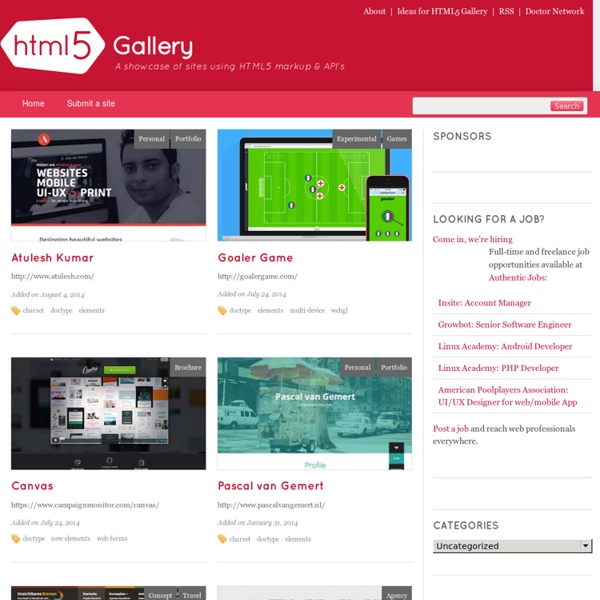



When can I use... Support tables for HTML5, CSS3, etc location.hash is dead. Long live HTML5 pushState! For a long time, location.hash was a way for AJAX applications to get back button and bookmarking support, and libraries like jQuery BBQ from Ben Alman made dealing with it cross browser a cinch. Now, with HTML5 coming of age, there is a new feature that aims to replace the use of location.hash with a better solution: pushState. Over on the Spoiled Milk blog, Jamie Appleseed describes the API as “a way to change the URL displayed in the browser through JavaScript without reloading the page.” It works on the history object like this: window.history.pushState(data, "Title", "/new-url"); The last argument is the new URL. In order to support the back and forward buttons you must be notified when they are clicked. Currently, pushState has support from the latest versions of Safari and Chrome, and Firefox 4 will be supporting it as well. If you’d like to read a more in depth overview of these new features, you should check out the aforementioned blog post by Jamie Appleseed.
HTML5 Website Showcase: 48 Potential Flash-Killing Demos So you’ve heard all rumors about HTML5 would take over Adobe Flash. While most web community argues that it’s possible or not, you must be wandering what makes HTML5 so powerful that even giant company Apple wants to use it to replace Flash. That’s why this post exists, we’re not going to talk about what HTML5 can do, but show live demos of magical things that HTML5 can achieve with other language like JavaScript, so get ready to be inspired. Note: As HTML5 is not fully supported by certain web browser like Internet Explorer, you’re strongly recommended to use Firefox browser to view all HTML5 demos below. Animation The HTML5’s canvas element is the deciding factor for HTML5 to replace certain Flash animation. Audioburst Animation A comfortable and fantastic animation created with HTML5’s canvas and audio tag. Ball Pool Being showcased in the last Google I/O event, this demo shows you how dynamic can HTML5 be. Blob Sallad A HTML5-spawned creature that would please you. Bomomo Browser Ball Bubbles
The HTML5 test - How well does your browser support HTML5? adobe-webkit / Home / WebKit and Adobe Contributions 5lide: HTML5-based Slides Maker At last week's GTUG campout, a 3-day long HTML5 hackathon, I signed up to be a TA for the weekend. That meant I spent most of my time wandering around answering random questions and helping developers debug their hacks. But, I can't be surrounded by a bunch of people hacking on cool shit and not join in myself -- it's just way too tempting. So, on Friday night, after coming home from the pitches and discovering that drinking 2 Dr. Pepper's was not in fact a good way to avoid jet lag, I stayed up into the wee hours hacking on an idea I'd been brewing for a few weeks. As some of you know from my posts about Prezi and Ignite, I am a fan of alternative slide formats and presentation techniques. Early last year, the HTML5 advocates started using a set of slides that both showed off HTML5 features and were written in HTML5 - so they could do interactive samples and harness the power of HTML5 at the same time. Happy 5lide-ing!
Sneaking into Future: 25 Ultra Modern Websites Using HTML5 HTML5, the next major revision of HTML, the language of the internet, is set to revolutionize the way web developers and designers create websites and the way visitors use them. It’s being edited by Ian Hickson of Google and David Hyatt of Apple, two of the web’s greatest creative minds. Besides enabling web developers/designers to use cleaner, simpler, more consistent code, HTML5 will help them break free from the confines of 3rd party proprietary plugins like Adobe Flash. For the first time, it will be possible to achieve consistency between video player interfaces and overall website design. Users will be able to rotate, move, resize and even detect motion in a video while its playing, using inbuilt video controls. Through HTML5’s canvas element, users will be able to render graphics and images on the fly, again without the need for plugins. 1. 2. Pelletized is the site of Ed Wheeler, Oregon-based graphic/web designer and HTML/CSS developer extraordinaire. 3. 4. 5. 7. 8. 9. 10. 11.
HTML5 Presentation In March 1936, an unusual confluence of forces occurred in Santa Clara County. A long cold winter delayed the blossoming of the millions of cherry, apricot, peach, and prune plum trees covering hundreds of square miles of the Valley floor. Then, unlike many years, the rains that followed were light and too early to knock the blossoms from their branches. Instead, by the billions, they all burst open at once. Seemingly overnight, the ocean of green that was the Valley turned into a low, soft, dizzyingly perfumed cloud of pink and white. Uncounted bees and yellow jackets, newly born, raced out of their hives and holes, overwhelmed by this impossible banquet. Then came the wind. It roared off the Pacific Ocean, through the nearly uninhabited passes of the Santa Cruz Mountains and then, flattening out, poured down into the great alluvial plains of the Valley.
HTML5 presentation HTML5 Mania – HTML5 Showcase, HTML5 Gallery, Free HTML5 Templates